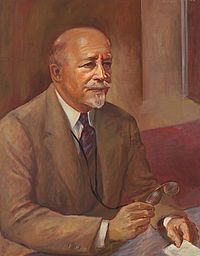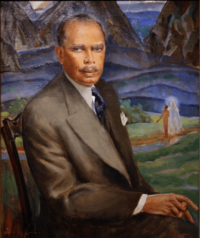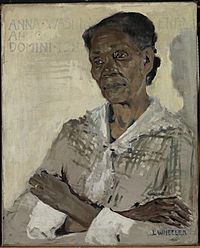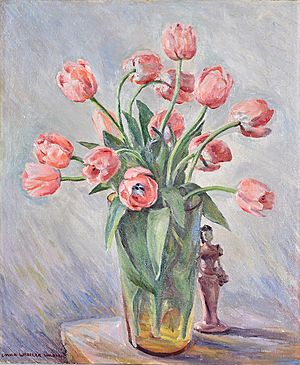Laura Wheeler Waring facts for kids
Quick facts for kids
Laura Wheeler Waring
|
|
|---|---|
 |
|
| Born | May 16, 1887 |
| Died | February 3, 1948 (aged 60) |
| Nationality | American |
| Known for | Painter |
| Spouse(s) | Walter E. Waring |
Laura Wheeler Waring (born May 16, 1887 – died February 3, 1948) was an American artist and teacher. She is famous for her paintings of important African Americans. She created these artworks during a special time called the Harlem Renaissance. Laura taught art for over 30 years at Cheyney University in Pennsylvania.
Contents
Early Life and Education
Laura Wheeler was born in Hartford, Connecticut, on May 16, 1887. She was the fourth of six children. Her parents were Mary (née Freeman) and Reverend Robert Foster Wheeler. Her family was very educated. They had five generations of college graduates before her.
Laura showed a lot of talent for painting in high school. She went to Hartford Public High School. After that, she studied art at the Pennsylvania Academy of the Fine Arts. She graduated from college in 1914.
In 1906, Laura started teaching art part-time. She worked at Cheyney Training School for Teachers in Philadelphia. This school is now known as Cheyney University. She taught art and music there until 1914. Teaching took up a lot of her time. This meant she didn't have much time to paint during those years.
First Trip to Paris
In 1914, Laura Wheeler Waring received a special award. It was called the A. William Emlen Cresson Memorial Travel Scholarship. This scholarship allowed her to study art in Paris, France. She studied at the Académie de la Grande Chaumière. She also traveled around Great Britain.
While in Paris, Laura often visited the Jardin du Luxembourg. She painted Le Parc Du Luxembourg (1918) based on her sketches from these visits. She also spent a lot of time at the Louvre Museum. There, she studied the works of famous artists like Monet and Cézanne. She felt that seeing these great paintings in person was much better than seeing copies.
Laura had planned to travel more in Europe. But her trip was cut short when World War I began. She had to return to the United States after only three months. Even though it was short, this trip was very important for her art. It gave her time to grow as an artist. The scholarship also helped her become more well-known.
Returning Home and Teaching
After her first trip to Europe, Laura went back to Cheyney University. She continued to teach there for over 30 years. She helped start the school's art and music departments. Later in her career, she became the director of the art programs.
Second Trip to Paris (1924–1925)
After World War I ended, Laura returned to Paris in June 1924. This second trip was a big turning point for her art style. She felt it was the most art-focused time in her life. She spent about four months in France. She learned a lot about French culture.
During this trip, she started painting many portraits. In October, she enrolled again at the Académie de la Grande Chaumière. She also showed her artwork in Parisian art galleries for the first time. Her painting style changed during this period. She started using brighter, more realistic colors. Houses at Semur, France (1925) is an example of this new style. This painting shows her use of vivid colors and light. This style became a key part of her work for the rest of her career.
Later Artworks and Recognition
Laura Wheeler Waring was one of the artists featured in the first exhibition of African-American art in the United States. This show was held in 1927 by the William E. Harmon Foundation. The Harmon Foundation asked her to paint portraits of important African Americans. She chose some people connected to the Harlem Renaissance.
Her artwork was shown in major American museums. These included the Corcoran Gallery in Washington, D.C., the Brooklyn Museum, and the Philadelphia Museum of Art. Today, some of her portraits are in the Smithsonian National Portrait Gallery.
In 1944, eight of her portraits were part of a book called Portraits of Outstanding Americans of Negro Origin. She painted famous people like Marian Anderson, W.E.B. DuBois, and James Weldon Johnson.
Besides national shows, Laura also participated in local exhibitions in Philadelphia. She created artwork for a show at the Berean School in 1930. She also wrote and illustrated a short story called "Dark Algiers and White." This story was published in The Crisis magazine.
Personal Life
Laura Wheeler married Walter Waring on June 23, 1927. Walter was a teacher in the public school system in Philadelphia. They didn't have much money at first. So, they waited two years for their honeymoon. In 1929, they traveled to France together for over two months. Laura and Walter did not have any children.
Death
Laura Wheeler Waring passed away on February 3, 1948. She died in her Philadelphia home after being sick for a long time. A year later, the Howard University Gallery of Art held an exhibition to honor her work.
Her paintings were also included in a 2015 exhibition. This show was called We Speak: Black Artists in Philadelphia, 1920s-1970s at the Woodmere Art Museum.
Selected Works
- Heirlooms (watercolor) (1916)
- Anna Washington Derry (1927)
- A Dance in the Round (1935)
- Still Life with Tulips and Figurine (around 1940)
- Portrait of Alma Thomas (1945)
Selected Portraits
 |
 |
 |
 |
| W. E. B. Du Bois | James Weldon Johnson | Anna Washington Derry | Alice Dunbar Nelson |
Images for kids
See also
 In Spanish: Laura Wheeler Waring para niños
In Spanish: Laura Wheeler Waring para niños




